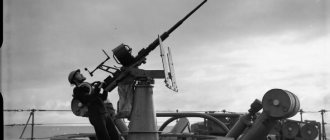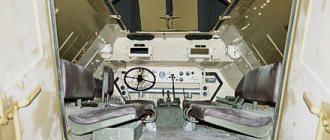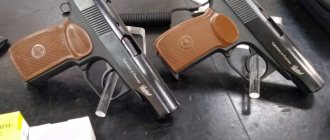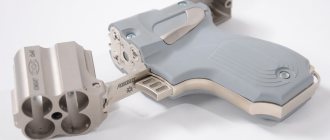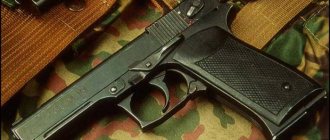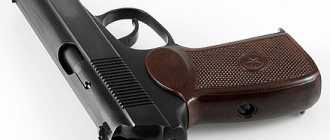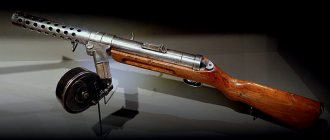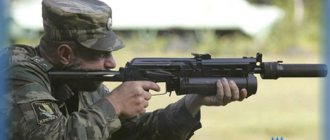Luger R.08 Parabellum - video
The introduction of smokeless powders kicked off the rapid development of automatic weapons, including self-loading pistols. In 1893, Berlin began producing the Hugo Borchard self-loading pistol. Although various "automatic" pistol systems had been proposed before, Borchardt was the first to achieve commercial success, which encouraged continued work. In 1898, Georg Johann Lueger, who served at , the successor of the Lewe company), significantly improved the Borchard system. The pistol has become more compact and lighter, and ergonomics have improved. Luger also modified the 7.65 mm Borchard cartridge with a bottle sleeve, a central location of the primer and a jacketed bullet.
In 1900, the pistol was adopted by the Swiss army. Only after this did DWM begin releasing the 7.65 mm Luger-Borchardt pistol (or simply “Luger”) onto the market. The pistol became better known as the “Parabellum”. The combination "Parabellum" - the second part of the famous Latin phrase "Si vis pacem, parabellum" ("Who wants peace, prepare for war") - was the telegraph code for DWM, was perceived as a trademark and as such became the designation of the newly introduced pistol. In 1902, Luger, based on the 7.65 mm, created a 9 mm cartridge for a military pistol. It is believed that the requirement to increase the caliber of the military pistol was put forward based on the experience of close combat during the suppression of the Yihetuan uprising ("Boxer Rebellion") in China in 1900, which revealed the insufficient stopping effect of the 7.65 mm cartridge bullet. When the caliber was increased to 9 mm, the base cartridge case was transformed from a bottle case into a cylindrical case by expanding the barrel. The 9-mm bullet initially had a cylindrical-conical shape with a flat platform on top, but since 1915 the cartridge was equipped with a cylindrical-ogive bullet, and this option became the main one.
During the modernizations of 1902–1906. A number of changes were made to the system of the pistol itself. This is how the so-called “Luger new” system was formed. In 1904, the German Navy adopted a 9 mm pistol model with a rear sight and a barrel length of 150 mm. In August 1908, the Reichswehr adopted a 9 mm model with a fixed sight and a 102 mm barrel under the designation P.08. Since DWM could not provide large supplies while maintaining proper quality, the arsenal in Erfurt was involved in fulfilling the order. There was also a “naval” model of 1908 with the same elongated barrel and reversible rear sight.
Pistol Luger R.08 Parabellum left view
The automatic pistol operated according to a short-stroke recoil pattern. Locking the barrel bore with the bolt was ensured by a system of two hinged levers located at the “dead center”. When the barrel and the bolt moved back, the rollers of the lever hinge ran onto the frame's ridges, the levers folded, unlocking the barrel bore and moving the bolt away from the barrel. At the same time, the return spring, located in the handle and connected by a crank lever to the rear locking lever, was compressed. The ejector located on top also served as an indicator of the presence of a cartridge in the chamber.
The striker-type trigger mechanism provided a shot only with preliminary cocking of the striker. Some of the trigger mechanism parts are installed on the left side of the frame; in combination with the “buttons” of the hinge, this increased the transverse size of the pistol. The safety lever in the lower position blocked the trigger lever and the movable automation system. A number of models, including “commercial” versions of the R.08, were equipped with an automatic safety device in the form of a button behind the handle - this safety device was automatically turned off when the handle was fully covered with the palm.
Pistol Luger R.08 Parabellum right view
A single-row magazine was inserted into the handle. When the cartridges were used up, the magazine feeder activated the bolt stop (introduced in 1913). Comfortable tilt and size of the handle, good balance contribute to shooting accuracy. Together with the power of the cartridge and the convenient location of the magazine latch, this determined the success of the pistol. The Parabellum system proved to be very sensitive, required complex machining and high precision parts, included many small parts, and yet remained popular for many years and in many countries due to the quality of its workmanship. Parabellum pistols of various models and calibers were at different times in service in three dozen countries, including Afghanistan, Bulgaria, Brazil, Holland, Greece, Denmark, Israel, Iran, China, Latvia, Lithuania, Portugal, Turkey, Finland, France , Chad, Switzerland, Sweden, Estonia. Pistols were also assembled in Switzerland, Great Britain, and Belgium. In Russia, Borchard-Luger pistols were not accepted for service, but back in 1907, the 9-mm Parabellum was recommended for officers to purchase at their own expense.
The finest hour of “Parabellum” can be called the First World War. By August 1914, the German armed forces had 250,000 R.08. In total, from the beginning of production to 1918, about 1,572,000 R.08 pistols were produced. The Reichswehr was also supplied with the LP.08 model with a barrel length of 200 mm, a sector sight up to 800 m (the capabilities of the weapon were significantly overestimated), and an attached holster-butt. This model was adopted in 1913 for the calculations of field artillery and fortress troops and is often referred to as “artillery”. In 1917, the LP.08 was equipped with a 32-round drum magazine.
In addition to the standard version P.08, in the early 1930s. Mauser-Werke AG has also begun production of a special version with an expansion type muffler. Special services such as the SD, Gestapo and military intelligence, the Abwehr, began to receive these weapons.
Having ceased production in 1920, DWM resumed it in 1923 under the name Berlin Karlsruhe Industrie Werke. In accordance with the restrictions of the Treaty of Versailles, only the 7.65 mm model with a barrel length of up to 100 mm was produced. Since 1930, the production of pistols, along with the rights, passed to Mauser Werke AG. For the Reichswehr and police, the R.08 was produced in reduced quantities and only . But in 1934, mass production of R.08 was resumed in Nazi Germany. It continued with Heinrich Krieghof until 1942. A total of 2,810,000 R.08 pistols were produced since its adoption, not counting other models.
Luger P.08 Parabellum pistol with an under-barrel flashlight. Such pistols were in service with the Imperial Security Service (RSD).
Modern Luger pistol
Having had a significant influence on the development of weapons, the Luger pistol has become a kind of standard for comparison. When creating new short-barreled systems, designers to this day often talk about achieving combat accuracy or other properties, similar to the Luger. The quality and high survivability of Luger pistols have allowed them to successfully survive to this day and become popular civilian and sporting weapons. The number of well-preserved older Lugers is quite large. Quite a few of these pistols are still preserved in army armories, including in Russia. Luger is often found in private weapons collections. Sometimes these pistols are found by lovers of antique weapons on the battlefields and then restored. In Switzerland, the Luger pistol is used as a sporting weapon. Large-scale production of the Luger pistol has already ceased, but in 1999, Mauser produced several samples of this weapon for its centenary. Mauser still produces a limited number of these weapons for collectors. In the USA, replicas of various modifications of the Luger are produced by several arms companies and are in significant demand, despite the fact that in civilian circulation there are many originals brought by the American military from Europe as trophies after the defeat of the Third Reich, as well as commercial samples brought to the USA even before the war. In Russia, due to the peculiarities of the legislation, Luger pistols can be found in private hands only in a deactivated form, like MMGs.
Models and their differences
M.1900
The Model 1900 was the earliest version of the Luger pistol. It was adopted by the Swiss army in 1900. This model inherited one feature inherent in Borchard pistols - a small bracket on the right side of the bolt hinge. Its task was to prevent the shutter from rebounding after it was closed. In reality it was unnecessary because when the bolt hinge is closed it is slightly below the line along which the recoil force acts, and therefore any action aimed at opening the bolt only pressed the hinge further against the receiver. Important elements of the M.1900 were a safety lever blocking the receiver, which was on the left rear of the frame, and a spring ejector, which was located on the flat top surface of the bolt. The M.1900 was chambered for the 7.65×21 mm cartridge. Barrel length 122 mm.
M.1902
M.1902 is a further development of the M.1900 variant. This model was created for the 9x19 mm Parabellum cartridge, as a result of which the barrel had to be made somewhat thicker and shorter than that of the previous model. Barrel length 102 mm. The bolt and magazine were also slightly modified. The number of rifling in the barrel was increased from four to six, and the dimensions of the frame and receiver became the same. In the final version of the M.1902, the frame, receiver and threaded barrel bushing were shortened by approximately 2 mm.
M.1904
The M.1904 variant became the first mass-produced version of the Luger pistol. The first purchase of this weapon occurred after the German Navy adopted the “9-mm Selbstladepistole 1904” with a barrel length of 147.32 mm, later known as the “naval model”. Certain innovations were introduced into the M.1904 variant, which then became standard for all Luger pistols. The conventional spring ejector has been replaced by a new type of ejector with a vertical tooth. The ejector is combined with an indicator of the presence of a cartridge in the chamber. The cartridge in the chamber raises the ejector upward. This model has a reversible sight at a distance of 100 and 200 m. At the bottom of the back of the handle there is a groove for attaching a holster-butt. Caliber 9 mm, length 262 mm, barrel length 147 mm, weight 915 g, muzzle velocity 350 m/s. From 1905 to 1918, DWM manufactured 81,250 Model 1904 pistols for the German Navy.
M.1906
For the first time, major changes were made to the M.1906 variant. The leaf return spring in the handle was replaced with a twisted, cylindrical one. The fuse design has also been changed; he himself was moved down and began to lock the sear. The top of the bolt was now semicircular, the hinge grips were made with a flat, diamond-shaped surface, and the anti-bounce bracket was removed. The M.1906 (or, as it came to be called, the “New Model Parabellum”) was manufactured in two versions - chambered for the 7.65 mm cartridge with a barrel length of 122 mm and for the 9 mm cartridge with a thicker barrel length of 102 mm.
M.1908
The Luger pistol of the 1908 model differs from the M.1906 in that the automatic safety was removed and only the flag safety remained. The M.1908 was most often called simply "Pistol 08", or P08. Like the 1906 model pistol, it has a cylindrical coiled return spring and an extractor, which is combined with an indicator of the presence of a cartridge in the chamber. With all the changes, the new “marine model” of 1904 was produced with the same name. In total, until 1918, the DWM weapons company produced 908,275 P08 for arming the army and 1,500 pistols for civilian purposes. In Erfurt, from 1911 to 1918, 663,600 units were produced.
9mm Parabellum pistol P.08 Lange
Artillery model
The so-called “Artillery Model” - a version of the 9 mm Luger pistol, called the Lange P08 (LP 08), was adopted on June 3, 1913 by units of Prussia, Saxony and Württemberg. This pistol-carbine is designed for shooting up to 800 m with an attached wooden holster-butt. The pistol is intended to arm crews of field artillery guns and non-commissioned officers of machine gun teams.
LP 08 with drum and stock
LP 08 with drum and stock
Advantages
— A fairly advanced design of a military pistol at the time of its creation. — Generally reliable operation in difficult operating conditions. — Convenient handle shape. — Excellent controllability when shooting. — Very little toss and recoil when fired. — Exceptional accuracy and accuracy of shooting, both aimed and offhand. — Robust and reliable design. — High rate of fire.
Flaws
— Many details of complex shape. Even the trigger has an intricate crescent shape. Its second end is a limiter, which should have another place. When descending from above, the other end of the crescent lowers, preventing you from shooting with gloves on. — The design does not allow closing the locking levers, protecting them from dirt or sand getting into the mechanism, which can cause a delay if a lot of dirt gets into the mechanism. — Delays when using cartridges with non-ogive bullets. — You cannot use cartridges with an increased charge of gunpowder for shooting to avoid damaging the weapon. — When shooting from the stomach, cartridges often fly into the shooter’s face.
Like other weapons of the early 20th century, the Luger was not highly technologically advanced. During the period of greatest production intensity, Mauser-Werke AG spent 12.5 man-hours on the production of one Luger; its production was quite labor-intensive. With the mass of the pistol itself being 0.87 kg, 6.1 kg of metal was required to produce it. During manufacturing, 778 separate operations were performed: 642 operations on machine equipment and 136 manually.
In 1939, the production cost of one Luger pistol by Mauser-Werke AG was 11.5 Reichsmarks, and the magazine for it was 3.15 Reichsmarks. The cost of a complete Luger pistol with two magazines was 17.8 Reichsmarks; the Mauser sold to the Wehrmacht more expensively - for 32 Reichsmarks, while the Mauser 98k rifle cost 70 Reichsmarks, and the MG-34 machine gun (itself expensive and replaced for this reason on MG-42) cost the Wehrmacht 300 Reichsmarks.
"Parabellum" M-1908 (Germany)
, Berlin; Prussian Royal Arms Factory, Erfurt. Type: automatic pistol (with recoil). Ammunition: 9 mm Parabellum cartridge. Overall Length: 8.78"/223mm. Unloaded weight: 30.0 oz/850 g. Barrel: 4.0 in/102 mm, rifled. Magazine: replaceable, box-shaped, eight rounds.
PARABELLUM.
A commercial version of the 7.65 mm P-08 pistol or "Model 1923", produced by DVM around 1929. From materials by Rolf Gminder.
PARABELLUM.
Sectional view of a 9mm Mauser Parabellum pistol model 29/70. Based on materials from INTERARMS.
Photo of the Parabellum pistol
Shutter closed
The shutter is cocked
Partial disassembly of the Luger P.08 Parabellum pistol
January 11, 2020 corrected by: OldMaster
